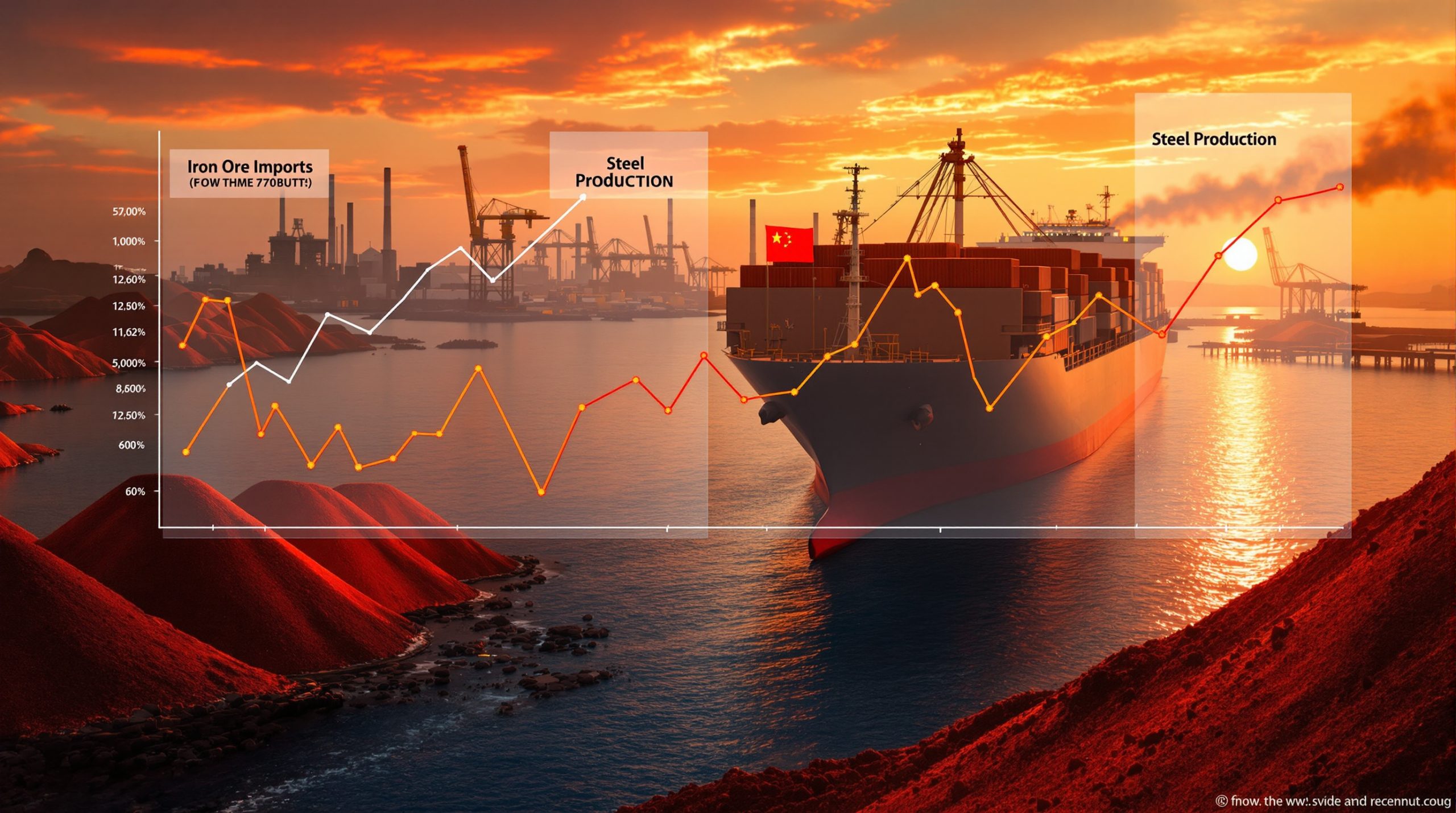Why Are SHFE Nickel Prices Increasing?
SHFE nickel prices have surged 1.42% in recent trading sessions, marking a significant shift in market dynamics that has caught the attention of commodity traders worldwide. This rally comes at a time when several factors are converging to create a perfect storm for nickel price appreciation, despite conditions that would typically suppress commodity values.
The recent price movement reflects fundamental supply-side pressures that have been building across global nickel markets. Industry analysts point to production constraints in key nickel-producing regions, creating an increasingly tight market. While the Shanghai Futures Exchange (SHFE) nickel contracts have shown particularly strong performance, this upward trend represents a broader structural shift rather than mere speculative activity.
"The nickel market is experiencing a fundamental recalibration of supply-demand dynamics that extends beyond typical commodity cycles," notes a recent Shanghai Metal Market (SMM) analysis.
Global Supply Constraints Driving the Rally
Despite a strengthening US dollar index, which rose 0.2% to 97.78 as of July 11, 2025, nickel has defied the typical inverse correlation between dollar strength and commodity prices. This unusual divergence highlights the severity of supply-side pressures currently supporting nickel values. Traditional market wisdom suggests that a stronger dollar should make dollar-denominated commodities more expensive for holders of other currencies, typically suppressing prices – yet nickel continues its upward trajectory.
The supply picture is further complicated by strategic inventory management across the value chain. With downstream consumers increasingly concerned about supply security, proactive stockpiling has accelerated, particularly among battery and alloy manufacturers who require high-grade nickel inputs for their production processes.
Macroeconomic Factors Influencing Nickel Markets
Recent US economic data has painted a picture of resilience, with jobless claims hitting a seven-week low. This economic strength potentially supports industrial demand for metals like nickel, which finds applications across numerous manufacturing sectors. The robust employment data suggests continued industrial activity that requires nickel inputs, from construction to advanced manufacturing.
Geopolitical tensions have added another layer of complexity to nickel markets. The United States recently announced plans for substantial new tariffs, including:
- 35% on Canadian imports (effective August 1, 2025)
- 50% on Brazilian goods (effective August 1, 2025)
- 25-40% tariffs on imports from 14 countries including Japan and South Korea
These trade actions create market uncertainty that often drives investors toward physical commodities as hedges against policy-induced volatility. Nickel, with its critical applications in both traditional industries and emerging technologies, has become particularly attractive in this environment.
How Does Nickel Compare to Other Metals Performance?
The recent 1.42% gain in SHFE nickel stands out even within a generally positive metals market. This outperformance suggests specific nickel-centric factors at play beyond the broader commodity sentiment.
Comparative Analysis of Base Metals Markets
When examining the broader base metals complex, nickel's outperformance becomes particularly noteworthy:
| Metal | SHFE Performance (July 11, 2025) | LME Performance (July 11, 2025) |
|---|---|---|
| Nickel | +1.42% | +0.20% |
| Copper | +0.13% | +0.06% |
| Aluminum | +0.12% | -0.06% |
| Zinc | +0.56% | +0.13% |
| Lead | -0.61% | -0.49% |
| Tin | -0.20% | -0.38% |
This comparative strength highlights the market's specific focus on nickel fundamentals rather than general metal market trends. The differential between SHFE and LME nickel performance (1.42% versus 0.20%) further suggests regionally specific factors influencing Chinese nickel markets more intensely than global markets.
Precious Metals and Ferrous Metals Correlation
Interestingly, nickel's rally coincides with strength in precious metals markets, with SHFE silver up 1.7% and COMEX gold rising 0.63%. This parallel movement indicates investors may be seeking both industrial and safe-haven assets in the current economic climate – a phenomenon typically observed during periods of economic uncertainty coupled with inflation concerns.
In the ferrous sector, the picture is even more bullish:
- Coking coal: +4.07%
- Iron ore price trends show increases of +2.07%
- Coke: +2.71%
- Hot-rolled coil: +1.30%
- Rebar: +1.29%
These robust gains in steel-making inputs suggest strong activity in the steel value chain, which ultimately impacts nickel demand for stainless steel production. The only exception is stainless steel futures themselves, which declined 0.12% – creating an interesting divergence between input costs and finished product pricing that bears watching.
What Are the Industrial Demand Drivers for Nickel?
The nickel market is experiencing a transformation in its demand profile, with traditional applications remaining strong while new growth vectors emerge at an accelerating pace.
Stainless Steel Production Trends
Despite stainless steel futures declining 0.12% in the latest session, this sector continues to represent the foundation of global nickel consumption. Approximately 70% of global nickel production is directed toward stainless steel manufacturing, making this application the cornerstone of market fundamentals.
Industry data indicates that Chinese stainless steel production has maintained resilience despite periodic economic headwinds. The stainless steel sector's nickel consumption provides a relatively stable baseline demand that helps buffer against market volatility. While price-sensitive, stainless producers have developed mechanisms to manage nickel price fluctuations through surcharges and other pricing tools.
"The stainless steel industry has evolved sophisticated mechanisms to manage raw material volatility, allowing it to maintain production volumes even during periods of nickel price appreciation," explains a metals procurement specialist at a major Chinese stainless producer.
The medium-term outlook for stainless steel production remains constructive, particularly in Asian markets where infrastructure development continues to drive demand growth. This sustained consumption creates a solid foundation for nickel market fundamentals.
Electric Vehicle Battery Sector Growth
The most transformative force in nickel markets is undoubtedly the accelerating adoption of high-nickel cathode chemistries in electric vehicle batteries. While the SMM report doesn't provide specific EV sales figures, industry projections consistently show this sector as the fastest-growing demand segment for nickel.
Battery manufacturers increasingly favor nickel-rich cathode formulations for their superior energy density characteristics:
- NCM 811 (80% nickel) batteries offer approximately 50-60% greater energy density than earlier LFP formulations
- NCMA formulations with 90%+ nickel content are now entering commercial production
- Each electric vehicle with high-nickel chemistry requires between 40-80kg of nickel (depending on battery size)
Market analysts project that by 2030, the EV sector could account for over 30% of total nickel consumption, compared to approximately 5-7% currently. This structural shift represents a fundamental transformation of nickel demand patterns that is likely to sustain higher prices over the long term.
The Chinese government's policy support for new energy vehicles and associated supply chains further strengthens this demand trajectory within the world's largest EV market.
How Are Chinese Policies Affecting Nickel Markets?
Chinese policy decisions continue to exert outsized influence on global nickel markets, with recent government initiatives signaling continued support for industries that consume nickel.
Strategic Industrial Policy Impacts
A July 10, 2025 meeting of China's State-owned Assets Supervision and Administration Commission (SASAC) emphasized the need to "accelerate the concentration of state-owned capital into forward-looking and strategic emerging industries." This directive signals potential increased investment in sectors requiring nickel, including advanced manufacturing and new energy technologies.
The SASAC directive is particularly significant for nickel markets because it suggests continued state-backed investment in:
- Electric vehicle manufacturing and associated supply chains
- Advanced materials development for high-technology applications
- Energy storage systems for renewable energy integration
- Next-generation electronics and telecommunications infrastructure
Additionally, Shanghai's Fengxian District has unveiled plans to develop high-purity materials for semiconductor applications, including "6N+ grade high-purity targets." While not explicitly mentioning nickel, this initiative aligns with growing demand for ultra-high-purity metals in advanced electronics, potentially creating new specialized demand channels for high-grade nickel products.
Environmental Regulations and Production Constraints
China's ongoing environmental policy implementation continues to shape domestic nickel production capabilities. The dual-control policy on energy consumption and intensity has particularly impacted energy-intensive processes like nickel pig iron (NPI) production, creating structural constraints on domestic supply.
These environmental pressures have accelerated a shift in the Chinese nickel market structure:
- Declining domestic NPI production capacity due to energy consumption limits
- Increased reliance on imported nickel products, particularly from Indonesia
- Growing premium for higher-grade nickel products with lower environmental footprints
- Acceleration of investment in battery recycling advances
The environmental regulatory framework has effectively created a two-tier market, with higher-quality, lower-carbon nickel products commanding growing premiums. This quality differentiation is likely to become more pronounced as China pursues its carbon neutrality goals.
What's Happening in Global Nickel Trading Patterns?
The nickel market is experiencing notable shifts in trading dynamics that provide insights into market sentiment and potential future price movements.
Trading Volume and Open Interest Analysis
Recent SHFE nickel trading patterns reveal increasing market participation, with volumes trending higher over recent sessions. This growing activity suggests heightened interest from both commercial hedgers and financial participants. While the SMM report doesn't provide specific volume figures, the price action coupled with volume increases typically signals stronger conviction behind market moves.
The differential between SHFE and LME nickel prices has widened, with SHFE nickel rising 1.42% compared to LME nickel's more modest 0.20% gain. This divergence creates potential arbitrage opportunities for international traders with access to both markets, though regulatory constraints and delivery logistics add complexity to such strategies.
Technical trading patterns show SHFE nickel breaking through key resistance levels, which typically attracts momentum-based trading strategies. This technical strength, combined with fundamental supply concerns, has created a self-reinforcing bullish sentiment in the short term.
Arbitrage Opportunities Between SHFE and LME
The price differential between SHFE and LME nickel contracts has created interesting trading dynamics. This spread reflects China's domestic supply-demand balance diverging from global markets – a situation that has become more common as China's environmental policies reshape its domestic production landscape.
Several factors contribute to this SHFE-LME divergence:
- Import restrictions and logistics challenges affecting physical arbitrage
- Different warehouse delivery specifications between exchanges
- China's strategic stockpiling policies affecting domestic availability
- Varying participation requirements for domestic versus international traders
Historically, such divergences eventually normalize, but the current regulatory environment may sustain this price gap longer than in previous cycles. Traders with the ability to operate in both markets can potentially capitalize on these spreads, though physical delivery requirements add complexity to pure financial arbitrage.
How Are Production Costs Influencing Nickel Prices?
The economics of nickel production have undergone significant changes, with rising input costs establishing higher floor prices for global production.
Energy Price Impacts on Nickel Production
Energy costs represent a substantial component of nickel production expenses, particularly for energy-intensive processes like smelting and refining. Recent energy price movements are adding pressure to producer margins:
- WTI crude oil: +0.54% (July 11, 2025)
- Brent crude oil: +0.42% (July 11, 2025)
- SHFE coking coal: +4.07% (July 11, 2025)
The impact is particularly pronounced for nickel pig iron (NPI) producers in Indonesia and China who rely heavily on coal-fired power. With coking coal prices rising over 4%, the cost structure for these operations has shifted significantly, creating a higher effective floor price for nickel production.
For high-pressure acid leach (HPAL) operations targeting battery-grade nickel production, energy typically represents 25-30% of operating costs. The recent energy price increases therefore directly impact the economic viability of projects targeting the growing battery sector.
Labor and Equipment Cost Inflation
Beyond energy inputs, broader inflationary pressures in mining industry innovation have elevated the all-in sustaining costs (AISC) for nickel miners globally. While the SMM report doesn't provide specific cost inflation figures, industry analysts have noted AISC increases of approximately 15-20% over the past 18 months across major nickel-producing regions.
This cost inflation has several implications for market dynamics:
- Lower-grade deposits become economically challenging to develop without higher nickel prices
- Existing producers face margin compression unless prices rise accordingly
- New project development requires higher long-term price assumptions to secure financing
- The cost curve steepens, with higher-cost producers setting effective price floors
These production economics fundamentally support current price levels, as producers require sufficient margins to justify continued investment in capacity expansion.
What Are Analysts Forecasting for Nickel Prices?
Market projections for nickel prices reflect a complex interplay of short-term technical factors and longer-term structural trends.
Short-Term Price Projections
Technical indicators suggest continued momentum for nickel prices in the near term. The breaking of key resistance levels around current prices opens potential for further gains in the coming weeks. While the SMM report doesn't provide specific price targets, the technical picture appears supportive of continued strength.
The short-term outlook is further bolstered by:
- Declining visible inventories across major exchanges
- Continued strength in manufacturing PMI data from major economies
- Seasonal patterns that typically show stronger demand in the third quarter
- Position concentration suggesting limited immediate selling pressure
These factors collectively support a constructive short-term view, though volatility remains an inherent characteristic of nickel markets due to relatively limited liquidity compared to other base metals.
Long-Term Supply-Demand Balance Outlook
Looking beyond immediate market dynamics, the long-term nickel outlook remains constructive but more nuanced. Significant new supply is expected to come online from Indonesia over the next 24-36 months, particularly in the form of integrated HPAL projects targeting battery-grade material.
However, this supply growth faces several countervailing factors:
- Accelerating demand from the EV sector as high-nickel cathode adoption increases
- Technical challenges in scaling up HPAL operations to meet quality specifications
- Environmental restrictions limiting expansion in traditional producing regions
- Growing quality differentiation between battery-grade and standard nickel
The quality spread between different nickel products is expected to widen, with battery-grade material commanding increasing premiums. This market segmentation may create a two-tier price structure, with battery-suitable nickel trading at substantial premiums to standard-grade material.
How Is Nickel Trading Affecting Related Industries?
The ripple effects of nickel price movements extend throughout multiple industrial value chains, creating both challenges and opportunities for downstream sectors.
Stainless Steel Manufacturer Responses
Stainless steel producers, facing a 0.12% decline in futures prices while input costs rise, are implementing various strategies to manage margin pressure:
- Accelerated adoption of raw material surcharge mechanisms to pass through nickel cost increases
- Exploration of lower-nickel-content alloy alternatives where technically feasible
- Just-in-time procurement strategies to minimize inventory exposure to price volatility
- Vertical integration efforts to secure nickel supply at predictable costs
The current price environment is particularly challenging for manufacturers with fixed-price contracts that don't include raw material escalation clauses. Industry reports indicate some manufacturers are accelerating their inventory cycles to minimize exposure to price volatility.
"Stainless producers are increasingly implementing sophisticated risk management systems to handle raw material volatility, including more dynamic pricing models and hedging strategies," notes an industry procurement specialist.
Battery Supply Chain Implications
For the battery supply chain, rising nickel prices present a complex mix of challenges and opportunities:
- Cell manufacturers with exposure to high-nickel cathode chemistries face margin pressure
- Research into more cost-effective formulations has accelerated, including silicon anode technologies that can offset some nickel requirements
- Recycling economics improve significantly with higher nickel prices
- Strategic partnerships between automakers and miners have increased to secure long-term supply
The improved economics for recycling are particularly significant for the long-term sustainability of the EV battery industry. With nickel prices at current levels, the recovery of nickel, cobalt, and lithium from end-of-life batteries becomes increasingly attractive, potentially accelerating investments in recycling infrastructure.
The battery industry's response to higher nickel prices may ultimately accelerate the transition to a more circular supply chain, with greater reliance on recovered materials supplementing primary production. Many automotive manufacturers are investing in development of nickel-rich resources to secure long-term supply for their EV production targets.
FAQ About SHFE Nickel Price Increases
What factors are driving the current SHFE nickel price increase?
The SHFE nickel price increase of 1.42% (as of July 11, 2025) is being driven by a combination of factors including global supply constraints, strong demand from stainless steel and EV battery sectors, rising production costs, and strategic stockpiling. Chinese industrial policies supporting strategic emerging industries are also creating supportive conditions for nickel deman
Looking for the Next Major Mineral Discovery?
Discover the substantial returns that significant ASX mineral discoveries can generate by exploring Discovery Alert's dedicated discoveries page, where their proprietary Discovery IQ model provides real-time alerts on actionable investment opportunities. Begin your 30-day free trial today at Discovery Alert and position yourself ahead of the market for the next nickel or battery metals breakthrough.




